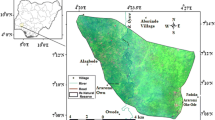Abstract
The destruction of forests, fires and illegal logging is one form of disturbance to forest resources and lately more and more frequent. Fires and deforestation pose enormous losses and the impact is vast, even across national borders. On the other hand, prevention and control efforts were undertaken so far have not provided optimal results. Therefore, it needs a thorough improvement, especially those related to the welfare of marginalized communities or in forest areas. Various improvement efforts are carried out, among others, in the field of extension to the community especially related to the factors causing forest fires, the enhancement of the capacity of government apparatus especially from the Ministry of Forestry, the improvement of facilities to prevent and overcome the forest fires and illegal logging, legal reform and the application of sanctions in assertive.
Similar content being viewed by others
Reference
Albrecht, A. T., Fortin, M., Kohnle, U., & Ningre, F. (2015). Coupling a tree growth model with storm damage modeling: Conceptual approach and results of scenario simulations. Environmental Modelling and Software, 69, 63–76.
Anderegg, William R. L., et al. (2013). Drought’s legacy: Multiyear hydraulic deterioration underlies widespread aspen forest die-off and portends increased future risk. Global Change Biology, 19(4), 1188–1196.
Bachelot, B., & Kobe, R. K. (2013). Rare species advantage? Richness of damage types due to natural enemies increases with species abundance in a wet tropical forest. Journal of Ecology, 101(4), 846–856.
Bachelot, B., Uríarte, M., Thompson, J., & Zimmerman, J. K. (2016). The advantage of the extremes: Tree seedlings at intermediate abundance in a tropical forest have the highest richness of above-ground enemies and suffer the most damage. Journal of Ecology, 104(1), 90–103.
Batke, S. P., & Kelly, D. L. (2014). Tree damage and microclimate of forest canopies along a hurricane-impact gradient in Cusuco National Park, Honduras. Journal of Tropical Ecology, 30(5), 457–467.
Brancalion, P. H. S., et al. (2018). Fake legal logging in the Brazilian Amazon. Science Advances, 4, 1192.
Díaz-Yáñez, O., Mola-Yudego, B., & González-Olabarria, J. R. (2017). What variables make a forest stand vulnerable to browsing damage occurrence? Silva Fennica, 51(2), 1–11.
Dupont, S., Pivato, D., & Brunet, Y. (2015). Wind damage propagation in forests. Agricultural and Forest Meteorology, 214–215, 243–251.
Hale, S. A., et al. (2015). Comparison and validation of three versions of a forest wind risk model. Environmental Modelling and Software, 68, 27–41.
Herfindal, I., et al. (2015). Associational relationships at multiple spatial scales affect forest damage by Moose. Forest Ecology and Management, 348, 97–107.
Mikich, S. B., & Liebsch, D. (2014). Damage to forest plantations by tufted capuchins (Sapajus Nigritus): Too many monkeys or not enough fruits? Forest Ecology and Management, 314, 9–16.
Pacifico, F., et al. (2015). Biomass burning related ozone damage on vegetation over the Amazon forest: A model sensitivity study. Atmospheric Chemistry and Physics, 15(5), 2791–2804.
Pohnan, E., Ompusunggu, H., & Webb, C. (2015). Does tree planting change minds? Assessing the use of community participation in reforestation to address illegal logging in West Kalimantan. Tropical Conservation Science., 8, 45–57.
Ribeiro, C., Valente, S., Coelho, C., & Figueiredo, E. (2015). A look at forest fires in Portugal: Technical, institutional, and social perceptions. Scandinavian Journal of Forest Research, 30(4), 317–325.
Suvanto, S., Henttonen, H. M., Nöjd, P., & Mäkinen, H. (2016). Forest susceptibility to storm damage is affected by similar factors regardless of storm type: Comparison of thunder storms and autumn extra-tropical cyclones in Finland. Forest Ecology and Management, 381, 17–28.
Win, R. N., Suzuki, R., & Takeda, S. (2012). Remote sensing analysis of forest damage by selection logging in the Kabaung Reserved forest, Bago Mountains, Myanmar. Journal of Forest Research, 17(2), 121–128.
Zhang, Y., & Liang, S. (2014). Changes in forest biomass and linkage to climate and forest disturbances over Northeastern China. Global Change Biology, 20(8), 2596–2606.
Zhou, Q., et al. (2014). Structure damage detection based on random forest recursive feature elimination. Mechanical Systems and Signal Processing, 46(1), 82–90.
Author information
Authors and Affiliations
Corresponding author
Additional information
Publisher's Note
Springer Nature remains neutral with regard to jurisdictional claims in published maps and institutional affiliations.
Rights and permissions
About this article
Cite this article
Hasyim, S., Abdullah, R. & Ibrahim, H. Forest damage and preservation through forest resources management in Indonesia. GeoJournal 86, 2183–2189 (2021). https://doi.org/10.1007/s10708-020-10177-5
Published:
Issue Date:
DOI: https://doi.org/10.1007/s10708-020-10177-5




